April 18th, 2012 · Comments Off on Book Review: Paintracking
Your first response to the title Paintracking might be, “Gee, I don’t want to track my pain. I try to run the other way!” But hold on. What you’ll find is a wonderful book on creating your own plan for more comfort and better living. My thanks to Deborah Barrett for writing this excellent resource!

Deborah developed pain when she was working on her PhD in Sociology at Stanford. She experienced the common difficulty many of us have had to reach a diagnosis, which was finally fibromyalgia and myofascial pain syndromes. Although an answer to what was wrong was helpful, it still left her struggling to figure out how to handle her chronic pain. This book is how she did just that. Deborah shares her own story of how she both improved her pain and was able to live more fully.
Paintracking is divided into 2 main sections, “Pain-Treating” and “Pain-Living.” Pain-Treating reviews issues such as:
- what health professionals will help you
- psychological skills to reduce and cope with pain
- ways to relax your body
- how to pace activities
- how to improve sleep
Pain-Living reviews issues such as:
- changes to make to your home to function better and easier
- suggestions for traveling
- changes to make to your work space and work life
- issues to address in relationships
The information reviewed in the book is comprehensive. She gives specific guidance, including worksheets and charts. This enables you to individualize the information provided in the book, and it encourages you to actively use the information. The writing is clear, and Deborah is positive and encouraging. I’d strongly recommend this book to newly diagnosed patients as an excellent guide to understanding chronic pain and living well despite it. I also think that even patients who have dealt with pain for a while would learn something new and helpful in its pages.
My only small quibble with the book is its title, and phrases such as “pain-living,” which to me suggest too much of a focus on pain. These could be turnoffs for potential readers who might otherwise really be helped. I think what Deborah has created is instead a “living well” guide, one that I hope you read and work through.
***To get every new article delivered to you for free the instant they're published, sign up for How to Cope with Pain by email or RSS feed.
Tags: 1
July 18th, 2011 · Comments Off on Book Review – The Pain Chronicles
This review was written by Tara White, RN.
The Pain Chronicles, by Melanie Thernstrom, is simply the best, most readable, most thorough and enjoyable pain book I’ve ever read. Melanie Thernstrom captures your attention from the first page in her meticulously researched masterpiece. She grabs hold of you, just as pain does; only you don’t want this pain thriller to end.
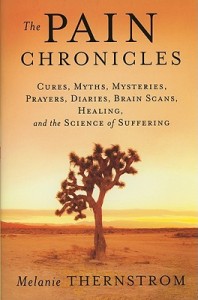
I wanted to shout, Yes! This is how I feel! I wanted my husband, my mother, and my daughter to read it to truly understand what living with chronic pain is all about. I wanted to hand it to all the well-meaning who ask, Are you feeling better yet? and, But you look so good. How do you explain that the pain is within, it’s part of you, redefining and reshaping all you think and do? Yet it’s invisible. It’s tethered itself to you and it plans to stay.
Melanie Thernstrom has mastered this, as only one who knows, can. She writes with incredible insight and graceful eloquence, with words that dance powerfully through all the invisible intricacies of the pained mind. She begins with potent and thought-provoking metaphors that capture the essence of true chronic and unending pain. Figures of speech such as,
this unhappy country on whose shores we have washed up after a voyage upon which we never sought to embark
and
a landscape where nothing looks entirely familiar and where even the familiar takes on an uncanny strangeness
describe our lives only too well. Furthermore, she compares pain to “a sour domestic partner,” intimate and ugly; a threatening, dirtying, distracting presence, yet one who refused to move out. Forceful analogies become vivid images to ponder. She compares chronic pain to a deer caught in a trap, the physiological terror and hormonal similarities; except only the human mind asks the all-important question,Why me? Functional and scientific explanations of pain pathways are given, yet are always interesting and basic, yet informative enough, for every level. Never is the reader left with a problem understanding or uninterested. Rather, one is creatively entertained and truly inspired.
Throughout the book, we get a smattering of her own personal pain journey, and only hidden in the acknowledgements do we learn her beautiful and enduring destination. Beginning with an intermittent and lingering neck and shoulder swimming injury as a young woman, Melanie’s pain becomes angry and chronic. Numerous physicians can’t diagnose her injury and prescribe treatments that sometimes even cause her more pain. She lives with self-doubt and loathing, always questioning herself. While is great pain herself, she ultimately uses her skills as a writer to research pain and the various relief methods used throughout history. These include everything from spiritual, religious and cultural beliefs and customs, to incredible technological discoveries.
From the beginnings of mankind, injuries and disease have prevailed. Despite great strides being made, medicine still can’t always fix it. Pain remains a mystery, a puzzle with seemingly never-ending pieces that must be located and formed into some shape to comprehend. Some fight and deny; others simply find ways to endure.
The truly terrifying component is that the central nervous system rewrites itself over time, sometimes causing permanent pain messages to travel from the injury site. Cognition can be affected, as parts of the brain can be damaged. Even scarier is that immune function may be impaired. The same hormones that regulate the way the brain deals with pain can impair immunity. Cortisol increases, causing abdominal weight gain with all of its associated dangers. Additionally, pain can cause the brain to atrophy. As pain becomes more irreversible, it may also be less responsive to therapy. Luckily, the author notes, pain is now recognized as a disease itself, rather than just a symptom. This new pain perspective has opened up a whole new paradigm of thought and research. As a consequence, there is now tremendous hope for pain practitioners and pain sufferers alike.
A version of this review originally appeared in the American Chronic Pain Association’s June newsletter, The Chronicle. I appreciate their sharing!
***To get every new article delivered to you for free the instant they're published, sign up for How to Cope with Pain by email or RSS feed.
Tags: 1
February 14th, 2011 · Comments Off on Chocolate & Vicodin Book Review
“It would have been easier if I’d been hit by a truck. Then I would have a story for how it began… But I wasn’t hit by a truck, or even a Volkwagen Bug. I was hit by a headache.” So begins the funny and informative Chocolate and Vicodin, told by the excellent story-teller Jennette Fulda.

Jennette recounts the story of developing a 24/7 headache, which she learns is now named “New Daily Persistent Headache.” She relates the saga of searching for a cure, which turns into hoping for any tiny measure of relief. The evaluations – doctor visits, blood draws, CT’s, headache diaries – go on and on.t one point, she receives a call from a doctor’s office to confirm an upcoming appointment, but doesn’t recognize the doctor’s name. “Who was Dr. Reiner and where was he going to stick a needle in me?” When the office reminds her that Dr. Reiner is her dentist, she writes, “It was official. I had more doctors than I could keep track of.” Chocolate and Vicodin also recounts the treatments she tries – medications, infusions, chiropractor visits, acupuncture – the mix of which threatens to become a full-time job.
Jennette’s story is an honest telling of a life with chronic pain. Her headaches nearly take over her life. There is the pain itself of course, but also getting lost in the wilderness of treatments, suffering, and a diminished life. She tells of her experience with directness and humor. She lies to her doctors. She still eats a lot of chocolate, which can be a headache trigger. She has some of the best metaphors for pain that I’ve read – her headache is “an invisible tiara of nails.”
I won’t reveal how the story ends, but Jennette also explores coming to terms with chronic pain. She writes, “Instead of living in pain, perhaps I could learn to live with pain, as if it were my partner instead of my master. It would always be there, but I didn’t have to let it boss me around.” This book would be a great read for anyone with headaches themselves, or with any type of pain. You’ll not feel so alone, and you’ll laugh. For those with a family member or friend in pain, read this to better understand the pain experience. Jennette will share with you what it’s really like.
***To get every new article delivered to you for free the instant they're published, sign up for How to Cope with Pain by email or RSS feed.
Tags: 1
January 3rd, 2011 · Comments Off on How to Be Sick Book Review
This book is spectacular! The author Toni Bernhard developed a post-viral illness in 2001, later diagnosed as Chronic Fatigue Syndrome. Although she was a serious student of Buddhist meditation already, this experience challenged her body, mind and spirit to its core. What she shares in How to Be Sick is how Buddhist-inspired practices have helped her cope with her illness and its consequences, as well as continue on her spiritual journey.
This is a book for people who will not be their old self again and for all those for whom, at least now, getting better isn’t possible. This is a book that most reassuringly says even to those people, “You, too, are going to be okay – even if you never recover your health!”
Some of the challenges she faced include:
- coping with symptoms that just won’t go away
- coming to terms with a more isolated life
- weathering fear about the future
- facing the misunderstanding of others
- adapting to so many unexpected and sometimes sudden life changes
The author reviews core beliefs in Buddhism as they pertain to her illness in a simple and helpful way, such as that suffering is a part of life, and that our wish for things to be different from the way they are creates suffering.
Buddhism also offered the author ways to move away from her suffering. She explains her coping techniques:
- finding joy in the life you can no longer lead
- how to soothe your body, mind and heart
- using compassion to alleviate your suffering
- facing ups and down with calmness and acceptance
For example, here are suggestions for when you’re sad and angry that you can’t do the social things you used to do. They are not glib “just see the positive” suggestions, but grow from a deep understanding of what a Buddhist approach can offer to heal your suffering.
- Cultivate joy for those who can enjoy activities
- Question how truthful the thoughts you may have are. Are you thinking, “I’m always going to be lonely,” or “I”ll never get out of the house again.” Are these accurate? Such catastrophyzing may be making you more upset.
- Stay in the present, rather than feeling sad about the past or worried about the future
- Move your attention to loving-kindness, compassion or calmness instead of focusing on unpleasant thoughts or pain
- Recognize the truth in the fact that we all will eventually experience a lessening of our ability to do things. Your time has simply come now. Then remember what you can still do.
These coping skills will come more naturally to someone familiar with Buddhist philosophy and practice. However, if you’re open to them, I believe they have much to offer regardless of your spirituality. I found the exercises very practical and clearly explained. They would benefit not just those with illness, but everyone in facing life’s challenges, and of any spirituality. I found this to be a beautiful book, full of wisdom. Toni opened her heart to show her own struggle and share what saved her. This book presents not just an approach to illness but a “life approach,” a philosophy of greeting life. It is a book – and way of life – well worth exploring.
***To get every new article delivered to you for free the instant they're published, sign up for How to Cope with Pain by email or RSS feed.
Tags: 1
November 10th, 2010 · Comments Off on Book Review: The Book of Calamities
I was excited to read Peter Trachtenberg’s new book, “The Book of Calamities: 5 Questions about Suffering and Its Meaning.”

From the subtitle, I was expecting an organized presentation of questions, followed by specific answers. When the book turned out not to be set up this way, I was initially frustrated. However, as I read more, my frustration soon turned into appreciation for what this book does offer. Trachtenberg is an explorer. He uses long stories to meander through different aspects of suffering, investigating and commenting on side paths and dead-ends. Rather than providing specific answers, he raises questions and provides ways we might consider the issues related to different types of suffering. I came to appreciate his storytelling more and more. Accompanying this author on a journey was more interesting than reading pat, dry answers.
Trachtenberg explores issues such as:
- visible vs invisible disease
- how religion in general copes with suffering vs how an individual gains support from his own spirituality
- individual pain vs a community tragedy
He looks at vast community challenges such as the genocides in Africa and the flooding of New Orleans, as well as more personal stories of individuals, such as twins living their lives with a disabling, terminal illness. In reality, there are no definite answers to the puzzle of pain and suffering. However, Trachtenberg’s work makes an excellent guide and companion in our ongoing contemplation of these central life questions.
***To get every new article delivered to you for free the instant they're published, sign up for How to Cope with Pain by email or RSS feed.
Tags: 1
October 13th, 2010 · Comments Off on Can Brain Re-training Work For “Central” Pain?
A reader Mark asks this interesting question about central pain:
As one with thalamic pain syndrome, the result of a brain hemorrhage, I’ve been interested in the work of Ramachandran in treating phantom limb syndrome with a mirror box, because it essentially demonstrates the potential of re-interpretation of pain signals for those of us whose pain is generated entirely from brain damage.
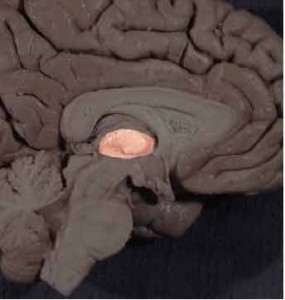
My pain occurs throughout the left half of my body, which has lost tactile sensation. The pain is a facet of wrong signals generated by an injured right thalamus deep in my brain. I practice revisualizing its invalidity, its untruth. by making my pain-free right side the other side of Ramachandran’s famous mirror box in my imagination. I move both arms in unison, eyes closed, focusing on the healthy right, making it the reality and repeating to myself, This together, both arms, is the truth, it is the quality of armness. The right side teaches the left this sensory truth, not totally or all at once, but enough to help.
It also reduces fear and helplessness, two terrible facilitators of pain. I would be interested to know if any research is being done in treating central or thalamic pain management in ways that draw upon Ramachandran’s path-breaking work.
“Central pain” is pain that is generated from the brain itself. Thalamic strokes are a common cause of central pain, in which the thalamic area is damaged and pain is a symptom of this. My understanding of Ramachandran’s work is slightly different from what Mark says above. Mirror therapy is thought to work on the brain in these ways:
- re-integrating accurate perception of sensation
- correcting the sense that the brain has of where a body part is, even without looking
- correcting the accuracy and ease of how the brain directs movement of a body part
The way I think about mirror therapy is that you’re correcting other functions of the brain (sensation, movement) and as a side benefit, pain decreases when these other things get corrected. So in a sense, I don’t think that pain gets reinterpreted, as much as these other functions return closer to normal and fewer pain signals are generated as a result of this normalization.
If the visualization Mark is doing decreases pain, that’s great! I believe visualization is a beneficial technique. In addition to this, however, I think there are other ways people with central pain might be able to use brain re-training techniques such as mirror therapy. There has been significant work using mirrors to help with movement after stroke. However, as far as I’m aware, there haven’t been studies done using mirror therapy for central pain after stroke. It’s not clear brain re-training would work, but this is what I would consider:
1. Do actual mirror work (not just in the imagination), with the painful side (in Mark’s case, the left) hidden behind a mirror. If bilateral movement increases pain on the left, just do movements on the right side. While doing movement, watch the reflection of the right side in the mirror. So you’d be looking towards the left side; your actual left side is hidden behind the mirror, so you’re watching the reflection of your right side.

2. To re-train touch, you can try 2 things; first, touch different textures directly on the left while watching what you’re doing. This is without mirrors. Or with mirrors, again put the left side behind the mirror, and touch the right side, again watching the reflection in the mirror.
3. Lastly, focus on the left (painful) side when doing bilateral movement. However, don’t focus on the pain, but on the sensations of normal movement on the left. People already try to ignore their painful sides, so getting your brain “re-aquainted” with the left side is crucial to restoring normalcy.
Mark, thanks for your interesting question.
***To get every new article delivered to you for free the instant they're published, sign up for How to Cope with Pain by email or RSS feed.
Tags: 1
October 8th, 2010 · 1 Comment
A reader Tim asks this intriguing question:
I have a chronic pain condition similar to CRPS, along with some nasty allodynia. Most mornings I feel like I’m 120 years old. I’m a big believer in graded motor imagery (GMI). However, I’m one of many people out there who have never seen a visual image in my mind. Almost always when somebody says “imagine”, they mean “visualize”. When someone asks me to imagine something, I have no idea what they’re talking about. This certainly gets in the way of any kind of motor imagery tasks.
I’m working with a very competent physical therapist, but this problem is intractable for him also. I have contacted Lorimer Moseley, and he doesn’t have any ideas on this either. Can you provide any guidance, information, etc. towards resolving this?
Thanks, Tim, for your really interesting question.
First, as you know, graded motor imagery is a step-wise program to retrain the brain away from pain. The steps are: 1) right/left discrimination, 2) imagining movement, and finally, 3) actually performing movement. It sounds like you’re asking how to do step #2 when it seems you can’t imagine movement.
When I prepare patients for step 2, I tell to look at, let’s say, their hand, and to imagine what it would feel like to move their hand into a certain position. When I do this myself, it’s sort of like the feeling of “willing” my hand to move, but without actually moving it. I try to “feel” the movement, more than imagine it. The looking at your body part is also an important part of the exercise – this step gives your brain reinforcement about paying attention to the part of your body, and being aware of where it is in space. This step is not about looking off and imagining some abstract hand moving into position, and not really about imagining movement in your mind’s eye. So it really is imagining the movement itself, not visualizing movement. You may be more able to do step #2 with these instructions.
2. If imagining movement was still hard for you, however, I would ask you to imagine doing a specific, well-known activity which is similar to the position you’re supposed to imagine. Let’s say you were using this picture for step #2 in GMI.
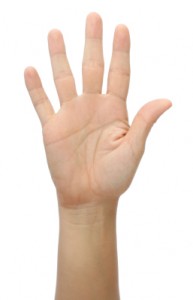
I might ask you to imagine raising your hand in class to answer a question. That gives you more of a context to use as guidance. You could even add specifics:
- notice how much you’re imagining your shoulder stretching when you raise your hand
- notice how far apart you’re imagining your fingers to be
A patient I worked with had a hard time imagining some movements. So I asked what movements were second nature to her, very well ingrained. She had played the piano for years and years, so we used particular movements involved with playing the piano. This was much easier for her to “feel”.
3. Lastly, there are other paths to get where you want to go besides “visualizing.” For example:
- I would also have you do work in other brain re-training techniques, such as tactile discrimination, using repetitive normal movement, using a mirror, etc. This can get you some of the same benefit as GMI.
- You can use other senses, such as hearing and touch. If you’re doing relaxation exercises, instead of “seeing” a beach, you could imagine bird sounds, or the sounds of the beach.
Thanks again for your question.
***To get every new article delivered to you for free the instant they're published, sign up for How to Cope with Pain by email or RSS feed.
Tags: 1
September 8th, 2010 · Comments Off on New Book: Working Together When Facing Chronic Pain
Working Together When Facing Chronic Pain has just been published. This book is designed for patients and written by their health professionals. I’ve contributed to several of the chapters. The book is available through Amazon.
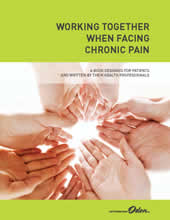
Working Together When Facing Chronic Pain is above all intended to give people suffering from any form of chronic pain food for thought and information about a large number of tools and treatments, as well as about the physiological, psychological and social aspects of pain. The loved ones of an individual suffering from chronic pain may also benefit significantly from this book since it will enable them to persevere in the search for short-, medium- and long-term solutions, in order to return to a more active, even a normal life. This work is also intended for all health professionals who want to learn more about the issues and aspects specific to chronic pain, and benefit from the experience of their colleagues and the testimonials of patients.
Education about chronic pain is one of the solutions to which this book opens doors.
The book is available en francais also. Disclosure: A small percentage of profits from the book will be divided among all authors, after expenses. Any payments I receive are donated to charity.
***To get every new article delivered to you for free the instant they're published, sign up for How to Cope with Pain by email or RSS feed.
Tags: 1
August 16th, 2010 · Comments Off on Can Phantom Limb Pain Be Prevented?
Up to 72% of people undergoing an amputation develop phantom limb pain (PLP). This type of pain is quite difficult to treat with medications or injections. However we do know that mirror therapy achieves excellent results in reducing or eliminating this pain.
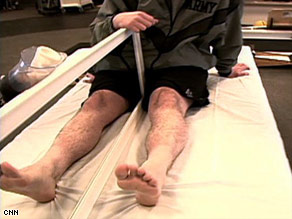
But how about preventing phantom pain?
Dr. Steven Hanling and others at the Naval Medical Center in San Diego had patients use mirror therapy prior to amputation in a small group of 4 men. The patients were young, active duty men, 3 having trauma due to explosions (IED’s) and 1 suffering a fall. They had experienced pain for 4-17 months prior to amputation. The patients used mirror therapy for 2 weeks prior to amputation. In mirror therapy, the painful body part, let’s say a hand, is put behind a mirror. The mirror is arranged so that it looks to the patient like he has 2 normal hands. While watching the reflected “good” hand in the mirror, the patient would do movements of either only the good hand or both hands.
It’s thought that by watching normal movement, the brain learns everything’s ok. In other words, the visual system is used to re-train the brain that movement is fine to do. Then, pain signals decrease.
In the study described above, 1 patient experienced no limb pain or phantom limb pain, 2 patients has mild limb pain and mild PLP, and the 4th patient had moderate limb pain with brief, moderate episodes of PLP. These are significant results and should encourage more studies of mirror therapy prior to amputation.
The study is: “Preamputation Mirror Therapy May Prevent Development of Phantom Limb Pain: A Case Series,” in Anesthesia and Analgesia, Vol 110, February 2010.
***To get every new article delivered to you for free the instant they're published, sign up for How to Cope with Pain by email or RSS feed.
Tags: 1
May 14th, 2010 · Comments Off on Even Brief Mindfulness Meditation Training Can Help
In the time it takes to watch a 1-hour TV show, you could learn a technique that helps with pain!
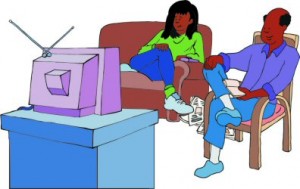
Researchers in the Department of Psychology at the University of North Carolina, Charlotte, taught participants mindfulness meditation for 20 minutes each day, over 3 days. They then tested how using this type of meditation helped people tolerate painful electrical stimulation. After learning mindfulness meditation, people rated the same electrical shock lower on a pain scale. As well, people could tolerate higher level shocks when using mindfulness exercises.
Mindfulness meditation worked better in these 2 areas than did relaxation exercises. Math distraction (doing math problems in your head) also resulted in people rating pain lower on a pain scale,but it didn’t help study participants tolerate higher shocks. This type of “experimental” pain is different from experiencing chronic pain, so this particular study doesn’t prove that mindfulness exercises help in chronic pain. But these results are consistent with other studies showing the benefits of mindfulness meditation for pain.
The article appeared in The Journal of Pain, Volume 11, March 2010, pages 199-209.
***To get every new article delivered to you for free the instant they're published, sign up for How to Cope with Pain by email or RSS feed.
Tags: 1









